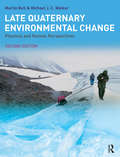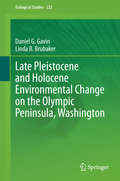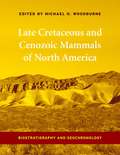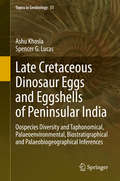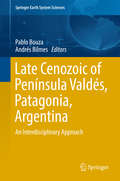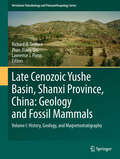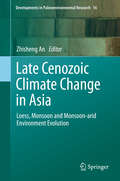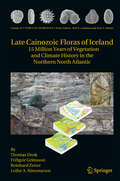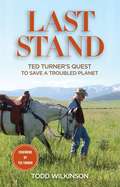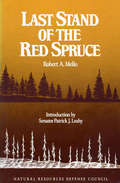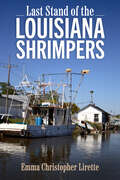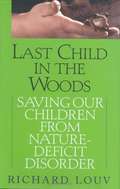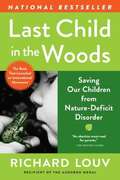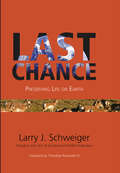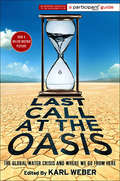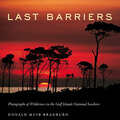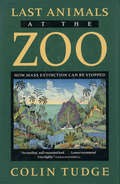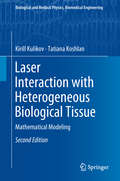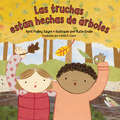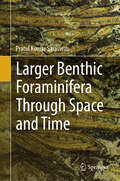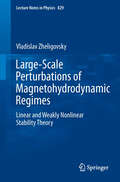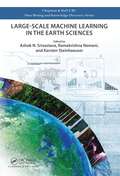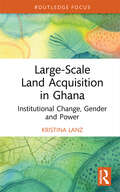- Table View
- List View
Late Quaternary Environmental Change: Physical and Human Perspectives
by Martin Bell M.J.C. WalkerLate Quaternary Environmental Change addresses the interaction between human agency and other environmental factors in the landscapes, particularly of the temperate zone.Taking an ecological approach, the authors cover the last 20,000 years during which the climate has shifted from arctic severity to the conditions of the present interglacial environment.
Late Pleistocene and Holocene Environmental Change on the Olympic Peninsula, Washington
by Daniel G. Gavin Linda B. BrubakerThis study brings together decades of research on the modern natural environment of Washington's Olympic Peninsula, reviews past research on paleoenvironmental change since the Late Pleistocene, and finally presents paleoecological records of changing forest composition and fire over the last 14,000 years. The focus of this study is on the authors' studies of five pollen records from the Olympic Peninsula. Maps and other data graphics are used extensively. Paleoecology can effectively address some of these challenges we face in understanding the biotic response to climate change and other agents of change in ecosystems. First, species responses to climate change are mediated by changing disturbance regimes. Second, biotic hotspots today suggest a long-term maintenance of diversity in an area, and researchers approach the maintenance of diversity from a wide range and angles (CITE). Mountain regions may maintain biodiversity through significant climate change in 'refugia': locations where components of diversity retreat to and expand from during periods of unfavorable climate (Keppel et al. , 2012). Paleoecological studies can describe the context for which biodiversity persisted through time climate refugia. Third, the paleoecological approach is especially suited for long-lived organisms. For example, a tree species that may typically reach reproductive sizes only after 50 years and remain fertile for 300 years, will experience only 30 to 200 generations since colonizing a location after Holocene warming about 11,000 years ago. Thus, by summarizing community change through multiple generations and natural disturbance events, paleoecological studies can examine the resilience of ecosystems to disturbances in the past, showing how many ecosystems recover quickly while others may not (Willis et al. , 2010).
Late Cretaceous and Cenozoic Mammals of North America: Biostratigraphy and Geochronology
by Michael WoodburneThis book places into modern context the information by which North American mammalian paleontologists recognize, divide, calibrate, and discuss intervals of mammalian evolution known as North American Land Mammal Ages. It incorporates new information on the systematic biology of the fossil record and utilizes the many recent advances in geochronologic methods and their results. The book describes the increasingly highly resolved stratigraphy into which all available temporally significant data and applications are integrated. Extensive temporal coverage includes the Lancian part of the Late Cretaceous, and geographical coverage includes information from Mexico, an integral part of the North American fauna, past and present.
Late Cretaceous Dinosaur Eggs and Eggshells of Peninsular India: Oospecies Diversity and Taphonomical, Palaeoenvironmental, Biostratigraphical and Palaeobiogeographical Inferences (Topics in Geobiology #51)
by Spencer G. Lucas Ashu KhoslaThis book documents analyses of the Late Cretaceous dinosaur nesting sites of the Lameta Formation at Jabalpur, Districts Dhar and Jhabua, Madhya Pradesh; Districts Kheda and Panchmahal (Gujarat); and the Pisdura, Dongargaon and Pavna sectors in the Chandrapur Districts of Maharashtra, which are exposed in India along an east-west and central axis. In this work, special emphasis has been given to the dinosaur nesting sites of the east-central Narbada River region, including its regional geology. The work was undertaken to provide detailed information concerning dinosaur eggs, eggshell fragments, nests and clutches found in the Lameta Formation of peninsular India. Prior to the present work there had been no detailed review of systematic work on the taxonomy, and of micro- and ultrastructural studies of dinosaur eggs and eggshells from the Lameta Formation. The study documents the field and laboratory investigations that facilitated the reconstruction of the morphotaxonomy, models for the burial pattern of eggs and eggshells, taphonomic implications,and the palaeoenvironmental context and palaeoecological conditions during the Late Cretaceous at the time of the extrusion of the Deccan traps, which may have been partly responsible for the extinction of the dinosaurs. The need to follow a parataxonomic classification for Indian dinosaur eggs and eggshell types is very apparent, and this book addresses this aspect in some detail. The emphasis on the application of parataxonomic schemes is based on the description of new oospecies and their comparison with previously known forms. The present work has led to the recovery of numerous nests, many collapsed eggs and hundreds of dinosaur eggshell fragments from the localities situated near the east, west and central Narbada River regions. It will be of interest to academics and professional palaeontologists, and all students of dinosaurs.
Late Cenozoic of Península Valdés, Patagonia, Argentina: An Interdisciplinary Approach (Springer Earth System Sciences)
by Pablo Bouza Andrés BilmesThis book presents extensive and new information on the Cenozoic marine and continental systems of one of the most important World Heritage sites of Southern South America: The Península Valdés. Using an interdisciplinary approach, that includes geological, biological and archeological perspectives of more than 30 specialists, an integrated description and analysis of the Cenozoic environments of the study region is presented. The volume brings together an update of the geology, climate, geomorphology, soils, biodiversity, archeology and human impact of the Península Valdés. The scope of this book extends to any natural science researcher of the world interested on the Cenozoic history of the Península Valdés.
Late Cenozoic Yushe Basin, Shanxi Province, China: Volume I:History, Geology, and Magnetostratigraphy
by Lawrence J Flynn Richard H Tedford Zhan-Xiang QiuThe Late Cenozoic Yushe Basin, Shanxi Province, China embodies the bulk of our knowledge on successions of terrestrial vertebrates in the northern part of East Asia. Everything we know about Asian mammals of the last 6 million years has a historical basis in the documentation of the geology of Yushe. This volume introduces the basin in its geological setting, describes the succession of fossiliferous strata, and shows how it is dated. It develops an unsurpassed level of precision for its age control. Geological maps and stratigraphic sections provide the backbone for individual studies to follow on varied fossil groups. The volume explores the history of exploration of the last century in Yushe Basin and places development of paleontology there into the context of the birth of the modern epoch of science in China.
Late Cenozoic Climate Change in Asia
by Zhisheng AnThis book is the first of its kind on environmental change research devoted to monsoon-arid environment evolution history and its mechanism involved. Capturing the most prominent features of Asian climate and environmental changes, it gives a comprehensive review of the Asian Monsoon records providing evidence for spatial and temporal climatic and environmental changes across the Asian continent since the Late Cenozoic. The dynamics underlying these changes are explored based on various bio-geological records and in particular based on the evidence of loess, speleothems as well as on mammal fossils. The Asian monsoon-arid climate system which quantifies the controlling mechanisms of climate change and the way it operates in different time scales is described. Attempts to differentiate between natural change and human-induced effects, which will help guide policies and countermeasures designed to support sustainable development on the Chinese Loess Plateau and the arid west.
Late Cainozoic Floras of Iceland
by Friðgeir Grimsson Leifur A. Símonarson Reinhard Zetter Thomas DenkBeing the only place in the northern North Atlantic yielding late Cainozoic terrestrial sediments rich in plant fossils, Iceland provides a unique archive for vegetation and climate development in this region. This book includes the complete plant fossil record from Iceland spanning the past 15 million years. Eleven sedimentary rock formations containing over 320 plant taxa are described. For each flora, palaeoecology and floristic affinities within the Northern Hemisphere are established. The exceptional fossil record allows a deeper understanding of the role of the "North Atlantic Land Bridge" for intercontinental plant migration and of the Gulf Stream-North Atlantic Current system for regional climatic evolution. 'Iceland sits as a "fossil trap" on one of the most interesting biogeographic exchange routes on the planet - the North Atlantic. The fossil floras of Iceland document both local vegetational response to global climate change, and more importantly, help to document the nature of biotic migration across the North Atlantic in the last 15 million years. In this state-of-the-art volume, the authors place sequential floras in their paleogeographic, paleoclimatic and geologic context, and extract a detailed history of biotic response to the dynamics of physical change.' Bruce H. Tiffney, University of California, Santa Barbara 'This beautifully-illustrated monograph of the macro- and microfloras from the late Cenozoic of Iceland is a worthy successor to Oswald Heer's "Flora fossilis arctica". Its broad scope makes it a must for all scientists interested in climatic change and palaeobiogeography in the North Atlantic region. It will remain a classic for years to come.' David K. Ferguson, University of Vienna
Last-Minute Survival Secrets: 128 Ingenious Tips to Endure the Coming Apocalypse and Other Minor Inconveniences
by Joey GreenLast-Minute Survival Secrets contains more than a hundred ingenious survival tips that may sound quirky at first, but really do work. Readers will discover a wide range of handy and unusual secrets to outsmart the unexpected and escape perilous situations using common, household products. Green shows how to start a campfire with potato chips, open a locked suitcase with a ballpoint pen, and prevent heatstroke with a disposable diaper. Readers will learn to build a solar cooker using cardboard and aluminum foil, a flood alarm with aspirin and a clothespin, and a wi-fi antenna with a coffee can. The book is even helpful for life's everyday disasters such as when a thunderstorm knocks out the power, the dog is sprayed by a skunk, or your car breaks down in the middle of nowhere. The book also includes interesting and goofy sidebars related to these survival tactics and fascinating trivia to keep you entertained until FEMA arrives. It's the perfect resource for armchair survivalists, budding MacGyvers, and adventurists on a budget.
Last Stand: Ted Turner's Quest To Save A Troubled Planet
by Todd WilkinsonEntrepreneur and media mogul Ted Turner has commanded global attention for his dramatic personality, his founding of CNN, his marriage to Jane Fonda, and his company's merger with Time Warner. But his green resume has gone largely ignored, even while his role as a pioneering eco-capitalist means more to Turner than any other aspect of his legacy. He currently owns more than two million acres of private land (more than any other individual in America), and his bison herd exceeds 50,000 head, the largest in history. He donated $1 billion to help save the UN, and has recorded dozens of other firsts with regard to wildlife conservation, fighting nukes, and assisting the poor. He calls global warming the most dire threat facing humanity, and says that the tycoons of the future will be minted in the development of green, alternative renewable energy. Last Stand goes behind the scenes into Turner's private life, exploring the man's accomplishments and his motivations, showing the world a fascinating and flawed, fully three-dimensional character. From barnstorming the country with T. Boone Pickens on behalf of green energy to a pivotal night when he considered suicide, Turner is not the man the public believes him to be. Through Turner's eyes, the reader is asked to consider another way of thinking about the environment, our obligations to help others in need, and the grave challenges threatening the survival of civilization.
Last Stand of the Red Spruce
by Robert A. MelloHere is a vitally important book for anyone who is concerned with acid rain and the fate of our forests. In his fascinating investigation into the decline of the red spruce on Camel Hump in Vermont, Robert A. Mello explores an ecological mystery. He presents, in clear, concise, non-technical language, both sides of an issue which has split the scientific community.Last Stand of the Red Spruce tells us the the time is long past-due to take action on acid rain. Mello urges pressure for legislation to preserve our health and warns us that we can no longer be complacent.
Last Stand of the Louisiana Shrimpers
by Emma Christopher LiretteIn recent years, shrimpers on the Louisiana coast have faced a historically dire shrimp season, with the price of shrimp barely high enough to justify trawling. Yet, many of them wouldn’t consider leaving shrimping behind, despite having transferrable skills that could land them jobs in the oil and gas industry. Since 2001, shrimpers have faced increasing challenges to their trade: an influx of shrimp from southeast Asia, several traumatic hurricane seasons, and the largest oil spill at sea in American history. In Last Stand of the Louisiana Shrimpers, author Emma Christopher Lirette traces how Louisiana Gulf Coast shrimpers negotiate land and blood, sea and freedom, and economic security and networks of control. This book explores what ties shrimpers to their boats and nets. Despite feeling trapped by finances and circumstances, they have created a world in which they have agency. Lirette provides a richly textured view of the shrimpers of Terrebonne Parish, Louisiana, calling upon ethnographic fieldwork, archival research, interdisciplinary scholarship, and critical theory. With evocative, lyrical prose, she argues that in persisting to trawl in places that increasingly restrict their way of life, shrimpers build fragile, quietly defiant worlds, adapting to a constantly changing environment. In these flickering worlds, shrimpers reimagine what it means to work and what it means to make a living.
Last Child in the Woods: Saving Our Children from Nature-Deficit Disorder
by Richard LouvFrom the Book Jacket: "I like to play indoors better 'cause that's where all the electrical outlets are," reports a fourth-grader. Never before in history have children been so plugged-in-and so out of touch with the natural world. In this groundbreaking new work, child advocacy expert Richard Louv direcdy links the lack of nature in the lives of today's wired generation-he calls it nature deficit-to some of the most disturbing childhood trends, such as rises in obesity, Attention Deficit Disorder (ADD), and depression. Some startling facts: By the 1990s the radius around the home where children were allowed to roam on their own had shrunk to a ninth of what it had been in 1970. Today, average eight-year- olds are better able to identify cartoon characters than native species, such as beetles and oak trees, in their own community. The rate at which doctors prescribe antidepressants to children has doubled in the last five years, and recent studies show that too much computer use spells trouble for the developing mind. Nature-deficit disorder is not a medical condition; it is a description of the human costs of alienation from nature. This alienation damages children and shapes adults, families, and communities. There are solutions, though, and they're right in our own backyards. Last Child in the Woods is the first book to bring together cutting-edge research showing that direct exposure to nature is essential for healthy childhood development-physical, emotional, and spiritual. What's more, nature is a potent therapy for depression, obesity, and ADD. Environment-based education dramatically improves standardized test scores and grade point averages and develops skills in problem solving, critical thinking, and decision making. Even creativity is stimulated by childhood experiences in nature. Yet sending kids outside to play is increasingly difficult. Computers, television, and video games compete for their time, of course, but it's also our fears of traffic, strangers, even virus- carrying mosquitoes-fears the media exploit- that keep children indoors. Meanwhile, schools assign more and more homework, and there is less and less access to natural areas. Parents have the power to ensure that their daughter or son will not be the "last child in the woods," and this book is the first step toward that nature-child reunion.
Last Child in the Woods: Saving Our Children from Nature-Deficit Disorder
by Richard Louv"The children and nature movement is fueled by this fundamental idea: the child in nature is an endangered species, and the health of children and the health of the Earth are inseparable. " --Richard Louv, from the new edition In his landmark work Last Child in the Woods, Richard Louv brought together cutting-edge studies that pointed to direct exposure to nature as essential for a child's healthy physical and emotional development. Now this new edition updates the growing body of evidence linking the lack of nature in children's lives and the rise in obesity, attention disorders, and depression. Louv's message has galvanized an international back-to-nature campaign to "Leave No Child Inside. " His book will change the way you think about our future and the future of our children. "[The] national movement to 'leave no child inside' . . . has been the focus of Capitol Hill hearings, state legislative action, grass-roots projects, a U. S. Forest Service initiative to get more children into the woods and a national effort to promote a 'green hour' in each day. . . . The increased activism has been partly inspired by a best-selling book, Last Child in the Woods, and its author, Richard Louv. " --The Washington Post "Last Child in the Woods, which describes a generation so plugged into electronic diversions that it has lost its connection to the natural world, is helping drive a movement quickly flourishing across the nation. " --The Nation's Health "This book is an absolute must-read for parents. " --The Boston Globe Now includes A Field Guide with 100 Practical Actions We Can Take Discussion Points for Book Groups, Classrooms, and Communities Additional Notes by the Author New and Updated Research from the U. S. and Abroad
Last Chance: Preserving Life in Earth (Speaker's Corner Ser.)
by Larry J Schweiger"This is an unabashed call to each and every American to moral duty for the future of life on earth," begins National Wildlife Federation president and CEO Larry J. Schweiger in this stirring exposé and call to action. Speaking to us not just as a conservation leader but also as an outdoor lover and a parent, Schweiger describes the causes and effects of global warming on our wildlife, ecosystems, and human life as we know it. With an engaging, down-to-earth tone (and a dash of wit; e.g., "What Happens in Greenland Will Not Stay in Greenland"), Schweiger breaks down the science behind our looming environmental catastrophe. Not letting go of hope, he also offers practical solutions and proposes a plan of action for everyday citizens. Last Chance will inspire each of us to take part in restoring the vital connection to our natural world before it's too late."
Last Call at the Oasis: The Global Water Crisis and Where We Go from Here
by Participant Media"If there was a price placed on clean water we might start treating it like it has value. Maybe when it's gone we'll realize we can't drink oil or money. " --Dave Matthews Less than 1 percent of the world's water is fresh and potable--and no more will ever be available. Thanks to pollution, global warming, and population growth, water access is poised to become today's most explosive global issue. This book, based on the film Last Call at the Oasis by Academy Award®-winning director Jessica Yu, offers insights into the coming water crisis from visionary scientists, policymakers, activists, and environmentalists, including: ROBERT MORAN on how oil and mineral development pollute and divert water supplies--often beyond public scrutiny PETER H. GLEICK on discovering the "soft path" to global water security ROBERT GLENNON on how the power of markets can help protect the world's water LYNN HENNING on how a family farmer became a passionate "water activist" ALEX PRUD'HOMME on how the water crisis affects us all GARY WHITE on how innovative social and economic strategies can make clean water available even for the world's poorest people HADLEY ARNOLD AND PETER ARNOLD on how arid regions like America's Southwest can wisely husband water supplies for cities and farmers alike ROBYN BEAVERS on how today's smartest businesses are making sustainable water management a competitive advantage ZEM JOAQUIN on nine "ecofabulous" ways of saving water at home--and doing it with style BILL MCDONOUGH on how smart design can preserve water's "Endless Resourcefulness" for generations to come No resource on earth is more precious--or more endangered--than water. Last Call at the Oasis is a powerful tool for learning about the water challenges we face as well as the remarkable solutions available to us--if we have the will to use them.
Last Barriers: Photographs of Wilderness in the Gulf Islands National Seashore
by Donald Muir BradburnRarely has a book of photography performed a more poignant and immediate service in preserving a natural Mississippi wonder. The Mississippi Gulf Coast barrier islands captured the heart and mind of Donald Muir Bradburn (1924–2012) in childhood. He became fascinated with the natural history and ornithology he witnessed. To him, the islands, especially Horn Island with its dark forests, high dunes, and deserted beaches, represented unbounded freedom and the ideal of a timeless world. Years later, when the National Park Service threatened to open the islands to “almost unlimited opportunities for camping, picnicking, water skiing, boating, bicycling, hiking, and bird watching,” Bradburn became an activist for preservation, focusing on saving Horn Island and Petit Bois Island as unchanged wilderness. In addition to supporting legislation that would keep both islands part of the National Wilderness System, Bradburn photographed the islands and their plants to show conservationist groups and individuals what was at stake and motivate them to join the fight. Eventually, through his efforts and those of others, Congress passed the National Parks and Recreation Act of 1978, which designated Horn and Petit Bois Islands as wilderness. For a time, the legislation saved a place shimmering with natural grace. After the fright and insult of the BP Deepwater Horizon oil spill in the Gulf of Mexico, Bradburn’s photographs are an even more deeply felt act of preservation. Last Barriers: Photographs from the Gulf Islands National Seashore is a collection of 120 images taken of the Gulf Coast islands that preoccupied his life and photography. The large majority of these are of Horn Island long before Hurricane Katrina and include landscapes in various weather conditions and during different times of the day, flora and fauna, and various habitats, seen either close-up or from afar. Each is accompanied by a detailed caption stating the date taken, the biological information of the species and plants depicted, and landscape descriptions. In a personal essay, Bradburn movingly reflects on his attachment to these island wonders and records the history of the efforts to save them.
Last Animals at the Zoo: How Mass Extinction Can Be Stopped
by Colin TudgeIn Last Animals at the Zoo, Colin Tudge argues that zoos have become an essential part of modern conservation strategy, and that the only real hope for saving many endangered species is through creative use of zoos in combination with restoration of natural habitats. From the genetics of captive breeding to techniques of behavioral enrichment, Tudge examines all aspects of zoo conservation programs and explains how the precarious existence of so many animals can best be protected.
Laser Interaction with Heterogeneous Biological Tissue: Mathematical Modeling (Biological and Medical Physics, Biomedical Engineering)
by Kirill Kulikov Tatiana KoshlanThis book introduces readers to the principles of laser interaction with biological cells and tissues with varying degrees of organization. In addition to considering the problems of biomedical cell diagnostics, and modeling the scattering of laser irradiation of blood cells for biological structures (dermis, epidermis, vascular plexus), it presents an analytic theory based on solving the wave equation for the electromagnetic field. It discusses a range of mathematical modeling topics, including optical characterization of biological tissue with large-scale and small-scale inhomogeneities in the layers; heating blood vessels using laser irradiation on the outer surface of the skin; and thermo-chemical denaturation of biological structures based on the example of human skin. In this second edition, a new electrodynamic model of the interaction of laser radiation with blood cells is presented for the structure of cells and the in vitro prediction of optical properties. The approach developed makes it possible to determine changes in cell size as well as modifications in their internal structures, such as transformation and polymorphism nucleus scattering, which is of interest for cytological studies. The new model is subsequently used to calculate the size distribution function of irregular-shape particles with a variety of forms and structures, which allows a cytological analysis of the observed deviations from normal cells.
Las truchas están hechas de árboles
by April Pulley Sayre¡Las truchas realmente están hechas de árboles! Hojas y bacterias, insectos y peces, osos y personas; todos somos parte de un gran círculo de crecimiento, alimentación y vida –¡ahora en español!Trout are really made of trees! Leaves and bacteria, insects and fish, bears and people, too—we're all part of one big circle of growing and eating and living--now in Spanish!Un hábil matrimonio entre un texto lírico e ilustraciones de montaje energéticas, este libro explora las formas intrincadas y a menudo sorprendentes en las que las plantas y los animales están conectados en la cadena alimentaria; con texto final que describe los esfuerzos de conservación y el cuidado responsable.A deft marriage of lyrical text, and energetic collage illustrations, this book explores the intricate and often surprising ways plants and animals are connected in the food web, with back matter describing conservation efforts and responsible stewardship.
Las enseñanzas secretas de las plantas: La inteligencia del corazón en la percepción directa de la naturaleza
by Stephen Harrod BuhnerRevela el uso de la percepción directa en la comprensión de la naturaleza, las plantas medicinales, y la sanación de las enfermedades humanas • Explora las técnicas utilizadas por los pueblos aborígenes y occidentales para aprender directamente de las propias plantas, incluidas las técnicas de Henry David Thoreau, Goethe, y Masanobu Fukuoka, autor de The One Straw Revolution [La revolución de una brizna de paja] Todos los pueblos antiguos y aborígenes afirman que sus conocimientos sobre remedios botánicos provienen de las propias plantas y no de la experimentación a través de pruebas y errores. El autor Stephen Harrod Buhner explora minuciosamente esta modalidad de cognición holística basada en el corazón a través de la obra de Luther Burbank, quien cultivó la mayoría de las plantas alimenticias que ahora consumimos sin pensar en su procedencia, y del gran poeta y científico alemán Goethe. Los lectores obtendrán los medios necesarios para recopilar información directamente del corazón de la naturaleza, aprender los usos medicinales de las plantas diagnosticar enfermedades, y comprender el proceso de creación de alma que se engendra mediante esa profunda conexión con el mundo.
Larger Benthic Foraminifera Through Space and Time
by Pratul Kumar SaraswatiForaminifera are single-celled marine organisms, usually less than a millimeter in size, and their fossil records extend back in geological time some 500 million years. Some foraminifera have grown to over 10 centimeters; these are informally called "larger benthic Foraminifera" (LBF). LBF are of outstanding value in field and in laboratory experiments. They can serve as geochemical proxies and can be used to learn about biology, biomineralization process, and more. Their study finds wide-ranging geological applications, including the carbonate platforms' past environmental changes and stratigraphy. There are many books on micropaleontology, fewer on Foraminifera and practically none on LBF. The ones that do exist are generally too specialized for micropaleontology and carbonate sedimentology doctoral students to utilize. This volume aims to fill this gap by providing readers with an understanding of the morphology and distribution of LBF in space (environment) and time (evolution). In addition, the isotope and trace metal proxies in LBF are discussed for paleoclimate reconstruction. This volume will benefit researchers and professionals in micropaleontology, hydrocarbon exploration, carbonate sedimentology, and paleoclimate.
Large-Scale Perturbations of Magnetohydrodynamic Regimes
by Vladislav ZheligovskyNew developments for hydrodynamical dynamo theory have been spurred by recent evidence of self-sustained dynamo activity in laboratory experiments with liquid metals. The emphasis in the present volume is on the introduction of powerful mathematical techniques required to tackle modern multiscale analysis of continous systems and there application to a number of realistic model geometries of increasing complexity. This introductory and self-contained research monograph summarizes the theoretical state-of-the-art to which the author has made pioneering contributions.
Large-Scale Machine Learning in the Earth Sciences (Chapman & Hall/CRC Data Mining and Knowledge Discovery Series)
by Ashok N. Srivastava Ramakrishna Nemani Karsten SteinhaeuserFrom the Foreword: "While large-scale machine learning and data mining have greatly impacted a range of commercial applications, their use in the field of Earth sciences is still in the early stages. This book, edited by Ashok Srivastava, Ramakrishna Nemani, and Karsten Steinhaeuser, serves as an outstanding resource for anyone interested in the opportunities and challenges for the machine learning community in analyzing these data sets to answer questions of urgent societal interest…I hope that this book will inspire more computer scientists to focus on environmental applications, and Earth scientists to seek collaborations with researchers in machine learning and data mining to advance the frontiers in Earth sciences." --Vipin Kumar, University of Minnesota Large-Scale Machine Learning in the Earth Sciences provides researchers and practitioners with a broad overview of some of the key challenges in the intersection of Earth science, computer science, statistics, and related fields. It explores a wide range of topics and provides a compilation of recent research in the application of machine learning in the field of Earth Science. Making predictions based on observational data is a theme of the book, and the book includes chapters on the use of network science to understand and discover teleconnections in extreme climate and weather events, as well as using structured estimation in high dimensions. The use of ensemble machine learning models to combine predictions of global climate models using information from spatial and temporal patterns is also explored. The second part of the book features a discussion on statistical downscaling in climate with state-of-the-art scalable machine learning, as well as an overview of methods to understand and predict the proliferation of biological species due to changes in environmental conditions. The problem of using large-scale machine learning to study the formation of tornadoes is also explored in depth. The last part of the book covers the use of deep learning algorithms to classify images that have very high resolution, as well as the unmixing of spectral signals in remote sensing images of land cover. The authors also apply long-tail distributions to geoscience resources, in the final chapter of the book.
Large-Scale Land Acquisition in Ghana: Institutional Change, Gender and Power (Routledge Studies in Global Land and Resource Grabbing)
by Kristina LanzThis book examines a large-scale land acquisition project for rice production in Ghana’s Volta Region, which has been purported by some to be a social and ecological showcase of a company entering a "community–private partnership" with affected communities. Celebrated by national and international media, the project has received substantial amounts of funding from various donor organisations and claims to empower women through its much-lauded outgrower project. Although discourses of "development", "sustainability" and "women’s empowerment" are used by the investment company, the state and the customary authorities to legitimise the large-scale land acquisition, this book highlights how the deal benefits mainly the powerful elite, including elite women, and generally increases the depreciation of those already most marginalised, such as poor female-headed households and settler communities that were dependent on resources from the commons now enclosed and transformed into a rice farm. The author adopts a New Institutionalist perspective in social anthropology in order to analyse how this land acquisition has been implemented in a plural institutional context and how different actors use different rules and regulations and associated legitimating discourses to increase their bargaining power and to pursue their own interests in a changing legal context. In addition, this perspective shows how benefits and losses are distributed along different intersecting axes of power, such as class, gender, clan membership and age. By focusing on power, gender and legitimisation strategies in the context of institutional change caused by the large-scale land acquisition, this book fills a gap in the literature on large-scale land acquisitions while contributing to the development of a theoretical perspective on institutional change, power relations and ideological legitimisation. This book will be of great interest to students and scholars of land and resource grabbing, agricultural development and agribusiness, land management and development studies more broadly.
